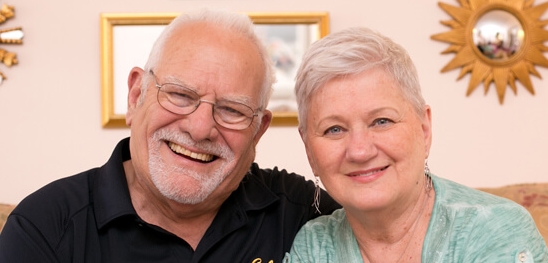“Walking in to RWJ Hamilton’s rehab department is like coming home"

Bordentown couple trusts RWJ occupational therapy for post-surgical rehabilitation
Whether it’s with their dog, Daisy, their grandchildren, or their commitments to teach driving safety and help place foreign exchange students, Gini and Stephen have their hands in a lot of things.
Those hands, however, have hit a few obstacles along the way. Between the two of them, they have experienced multiple trigger fingers, carpal tunnel syndrome and ulnar nerve entrapment. While surgery was performed to repair the problems, the couple credits occupational therapy (OT) with their return to normal function.
OT is Key
Occupational therapy is defined by the use of therapeutic occupations to address deficits in physical, cognitive, psychosocial, or other aspects of performance in one’s day-to-day life. “Occupations” will vary from person to person, but the term refers to activities that you do on a regular basis at home, work, school or anywhere you want or need to be.
Sometimes OT is needed for a congenital condition, or one with which an individual is born. Other times the need is a result of illness or injury.
In Gini and Stephen’s cases, therapy was received following surgery to help maximize use of the hand.
“I didn’t receive OT when I had my first trigger finger surgery,” says Gini. “My hand would bind up and I had discomfort. Having had the OT, my hand is in good shape again.”
While the need for an occupational therapist following hand surgery depends upon the surgery and what’s involved, most surgeons will prescribe OT for best results.
RWJ occupational therapists, including Diane Barus, OTR/L, have worked with both Gini and Stephen following their various surgeries.
“OT helps to ensure maximal recovery of hand function following surgery by focusing on range of motion exercises, scar management, desensitization, and functional tasks which are meaningful to the patient,” she explains.
Stephen offers an example: “I had some trouble gripping the steering wheel of the car,” he recalls. “Diane gave me what was, essentially, a broomstick. I had to hold and bend at the wrist. Now, that is much, much better.”
A combination of regular appointments in the office with exercises to do at home helps patients to make a quick recovery and avoid further problems and discomfort.
“Interviewing the patient and learning what he or she wants and needs to do can help us to develop a plan and goals. Keeping the patient motivated is essential,” Barus explains.
“Diane is so bright and gives you great instruction and suggestions,” adds Gini. “She tries to find new ideas, and new tools and toys to work with.”
Walking in to RWJ Hamilton’s rehab department is like coming home. From the front desk, to the therapists, to the other patients, you always have support and encouragement there.
Built on Trust
For years, Gini and Stephen have trusted their rehabilitation care to the RWJ rehabilitation team of therapists. What started out as a local, convenient care option years ago quickly became an essential ingredient for them to return to doing the things they love to do.
Going into any rehabilitation scenario, pain is a primary concern for many patients. For Stephen, this was a stand-out part of the RWJ rehabilitation team’s approach.
“These therapists are highly conscious of the patient’s comfort,” says Stephen. “Too many people take the ‘no pain, no gain’ approach. They’ve taught us, if you’re in pain, stop. Don’t force it. They want to give you the tools to strengthen, but without overdoing it.”
Gini agrees, and adds the care environment and compassion also go a long way. Which is why she won’t go anywhere else for any future rehabilitation needs.
“Walking in to RWJ Hamilton’s rehab department is like coming home,” Gini says. “From the front desk, to the therapists, to the other patients, you always have support and encouragement there.”